Michael Hamilton, the 2022 United States National Champion, shocked the world when he registered a card that had widely been considered draft chaff for his Iyslander CC deck. Wounded Bull is an unassuming generic common with rules text that only the most devoted of players would have remembered off the top of their heads. But in Hamilton’s deck, it served a very important role as a hyper-efficient attack using minimal cards, a unique niche for the card that had previously been undiscovered.
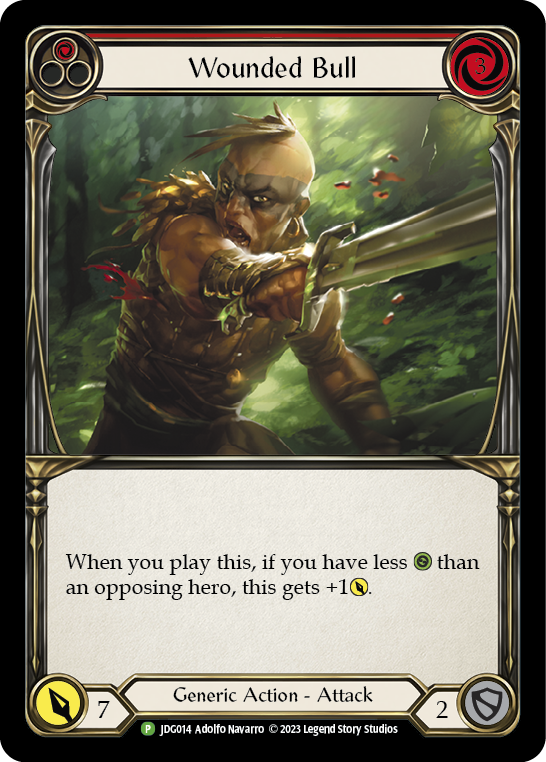
While Flesh and Blood’s card pool is still relatively shallow, there are clearly some diamonds in the rough waiting to be mined and refined from the game’s pool of approximately 1,500 cards. Inspired by Michael’s resourcefulness, I’ve sifted through every generic in the game and attempted to dig up a handful of cards in the same class as Wounded Bull: unassuming and underappreciated. Let’s take a look at some cards that should probably see more play in Classic Constructed.
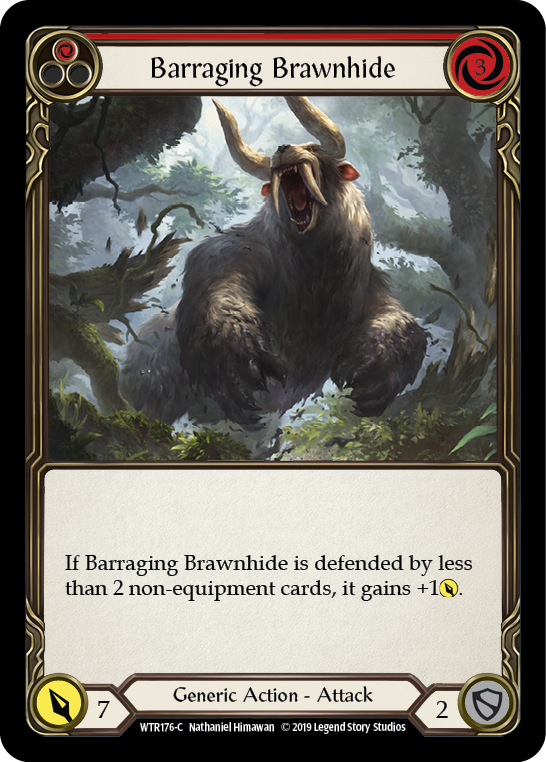
Barraging Brawnhide is the single most likely card in the game to give Wounded Bull a run for its money as “the easiest way to attack for 8 power with 2 cards.” But here, the condition on the additional +1 power is slightly different. With Wounded Bull, you have agency to let your life be lowered by virtue of not blocking; whereas with Barraging Brawnhide, you give your opponent agency to decide if they want to block with multiple cards and mitigate the efficiency of your attack. Of course, this caveat is frequently a moot point against decks that hate blocking, which means that Barraging Brawnhide still has plenty of utility as a hyper-efficient attack. Bully Iyslander, dual-wield Dorinthea, and other value-oriented decks will love this attack as a sideboard option against the right matchups.
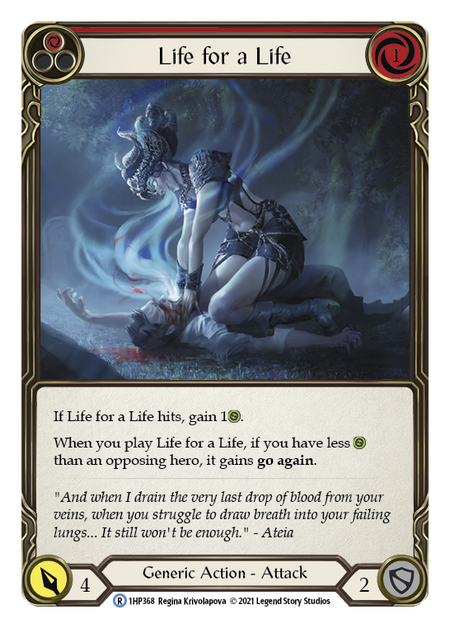
This Arcane Rising bulk rare is quietly one of the most efficient cards in the game. It has the same condition as Wounded Bull to unlock its full power: gaining unconditional go again. Its on-hit effect is unassuming, but effective; don’t let this card deceive you, it’s functionally a 1-for-5 go again. Combined with a blue and a weapon that can attack for 4 power from 2 resources, and you’ve brewed up a 2-card hand that presents a whopping 9 damage! This card seems made for Brute, who can pose some disgustingly efficient turn cycles following Life for a Life up with Romping Club or even Swing Big.
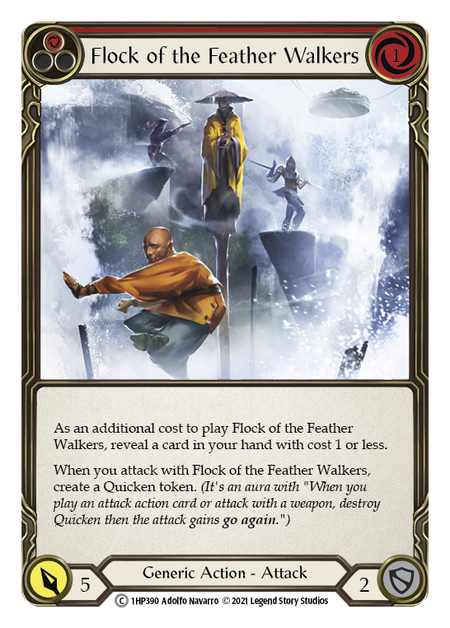
Remember how we were just talking about a 1-for-5 go again attack being above rate? Flock of the Feather Walkers is functionally very similar, yet sees a disappointing lack of play. It’s true that in the Cheerios Briar and Casino Starvo metas of yesterday, decks didn’t have the breathing room to end on a 1-cost attack and arsenal a cheap power card, but times have changed and the meta has reasonably slowed. Flock also has a proven track record in Classic Constructed - it was a key card in the final iterations of Chane before Seeds of Agony was banned, as a way to grease the wheels of early turns before the Soul Shackle banish engine was fully up and running. Unconditional go again on the first attack of the next turn is a powerful tool that Ninjas, Warriors, Runeblades, and so many other heroes love having access to - just about every deck that wants to play more than one cheap attack in a turn should consider giving Flock of the Feather Walkers a second chance.
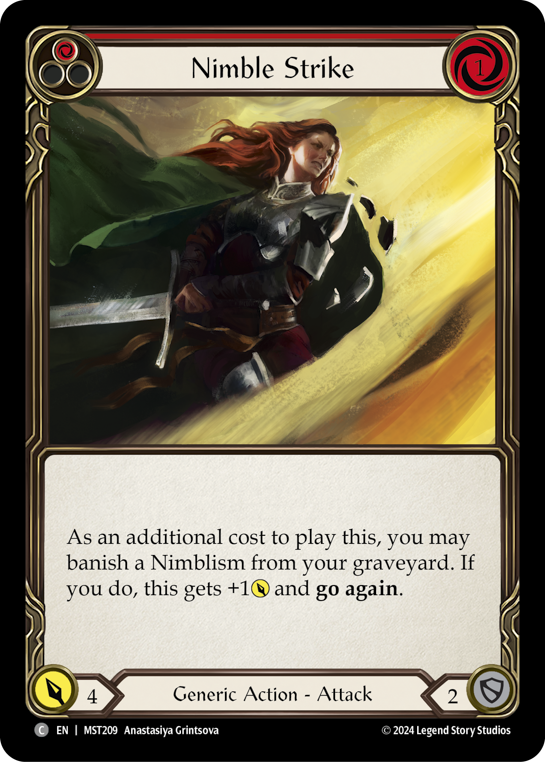
Anyone who’s drafted Welcome to Rathe should be familiar with the one-two punch of Nimblism into Nimble Strike as two cards and one resource for 8 power and go again (a recurring theme here seems to be the above-rate deal of 1 for 5 attacks with go again). It’s strange to me that there are some CC decks that happily play 3 copies of red Nimblism but not even a singleton red Nimble Strike. Consider Briar, who often pitches a blue to activate Grasp of the Arknight and swing Rosetta Thorn after playing a 0-cost attack action. The 1 cost on Nimble Strike replaces Grasp and threatens similar damage, but it has natural go again if you banish the Nimblism, which Briar usually has to work for via generating Embodiments of Lightning. Nimble Strike will never be an all-star, but it’s a worthier bread and butter card than most brewers give it credit for.
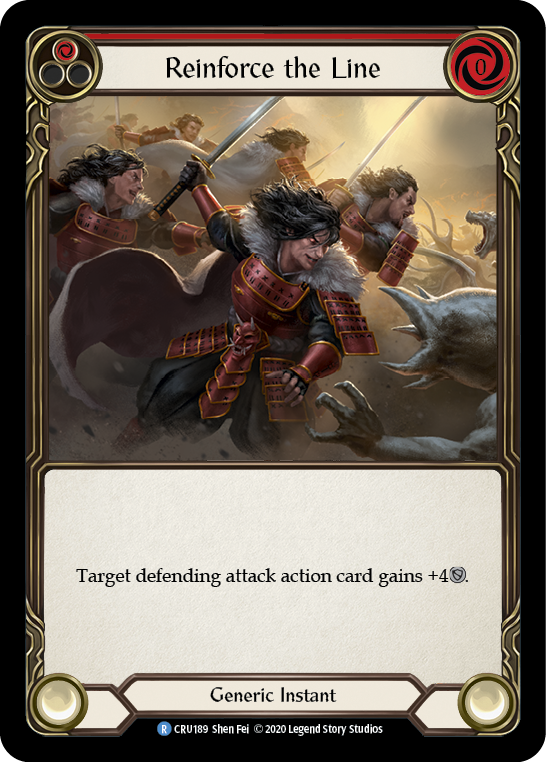
An oft-forgotten and criminally underplayed instant, Reinforce the Line lies somewhere between Fate Foreseen and Unmovable as far as dedicated defensive cards go. While it requires a two-card commitment, it offers unique advantages over its cheaper and more expensive defense reaction cousins; being an instant, it gets around dominate from hand compared to Sink Below, and it being free means that the leanest of aggressive decks - decks that don’t have blues to spare - have a much easier time playing it than Unmovable. This card has a perfect home in Ninjas that don’t have a glut of resources to spare, especially considering their decks are frequently more than 85% attack actions.
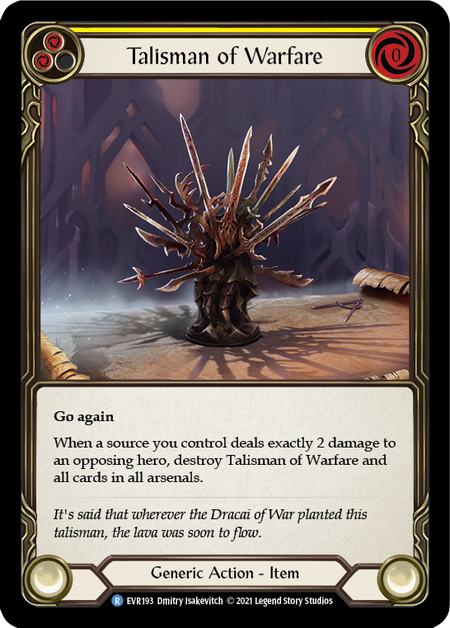
Rosetta Thorn singlehandedly makes Talisman of Warfare an absolute menace in Runeblade decks. It’s rare that Runeblades sit on their arsenal for more than a turn cycle, which means it’s rare that they’ll incidentally eat their own card with Warfare’s destruction effect - which makes this a nearly asymmetric hate card, especially against Rangers that value their arsenal highly. Additionally, consider that Talisman of Warfare is a non-attack action with go again, and it really starts to click as a useful utility card. You are almost always smoothly trading your one card for your opponent’s one card, except you get an upside: in Briar, half of an Embodiment of Lightning, and in Viserai, turning on your hero power for the turn. Combined with how annoying it is to stop the two sources of 2 damage from Rosetta Thorn, this Everfest trinket becomes a serious threat.
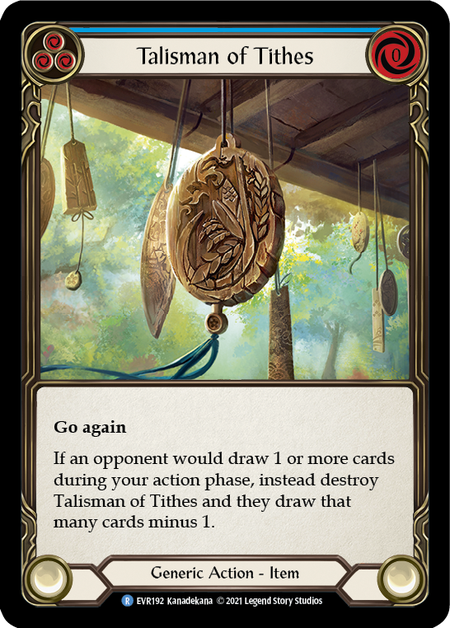
Talisman of Tithes has the narrowest application out of any other card on this list, but when it’s good, it’s great. As a blue non-attack action with go again, it’s a relatively “free” inclusion in many Runeblade decks, like Talisman of Warfare. Also like Warfare, Tithes trades one of your cards for one of your opponent’s cards - except this time it’s in the form of denying card draw, specifically from a defensive Crown of Seeds. With Tithes, the next time Oldhim wants to activate Crown on your turn, he needs to give up an entire card to do so. This is an incredibly potent way to arrest tempo if you can fervently push damage once the amulet comes down and not give Oldhim an off turn to safely Crown while going down a card. This strategy was particularly useful versus Bravo, Star of the Show to buy breathing room, as it made using Crown of Seeds to filter for a “Starvo Fusion” particularly difficult. You don’t get quite as much bang for your buck using Tithes against Oldhim, but it can still net you some very favorable turn cycles.
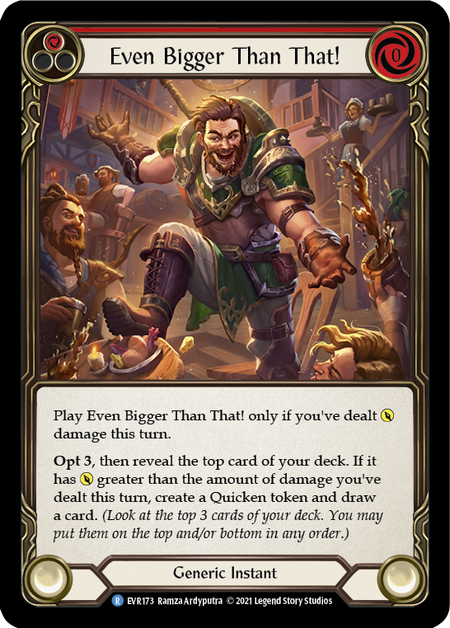
Even Bigger Than That (EBTT) has found a comfortable home in Classic Constructed in Katsu, where unblocked Harmonized Kodachis can be translated into smoothed-out combo lines through a little opting and a handy dandy Quicken token. There happens to be one other deck in the game that likes to go wide, has a small, cheap weapon, and really cares about what’s on top of its deck: Dash, Inventor Extraordinare. EBTT Dash isn’t a new invention - the rough idea has been floating around since the card was spoiled - but the deck has yet to break out into the mainstream. The basic principle is leading with the Pistol, sneaking in some damage, and then opting the top of the deck to give powerful generic attacks like Enlightened Strike go again via Quicken, all while you safely boost your Mechanologist attacks around the generics in your deck by knowing what the top card is before you banish it.
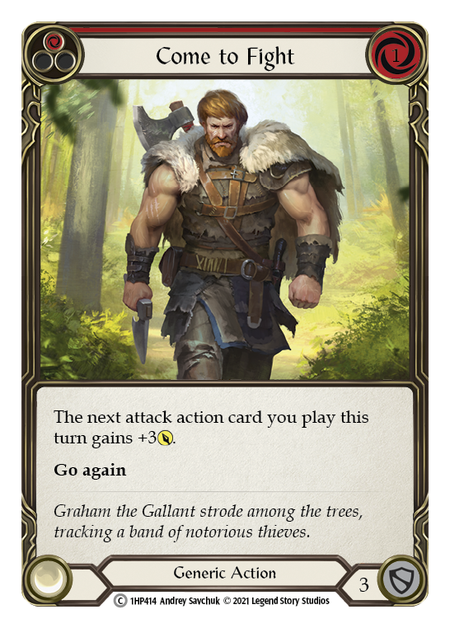
At first glance, Come to Fight is an expensive Nimblism. That assessment quickly changes when you notice its two distinct qualities: a critical extra point in defense, and a lack of a cost caveat for that +3 power. Both point towards a Runeblade that values efficient blocking and a blend of 0-, 1- and 2-cost attacks to fully take advantage of being free from the restrictions of Nimblism. These qualities combined make Come to Fight the midrange non-attack action buff. As modern Briar digs up non-attack action cards like This Round’s On Me and red Earthlore Surge, Come to Fight may be a serious consideration due to its flexible utility.
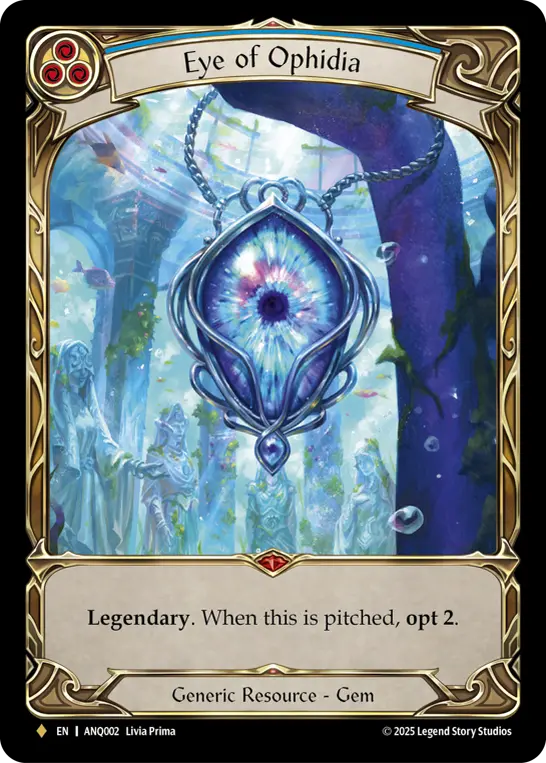
Many decks like to pitch blue cards to generate 3 resources. Many decks don’t like to block and therefore don’t mind including cards that don’t block. Many decks are synergistic, and sculpting half of their next hand could greatly benefit their damage output. Eye of Ophidia does all of these things. Eye’s effect is unconditional and almost universally useful, especially in decks that prioritize certain cards or card types depending on the situation in-game. Ethan “Man Sant” Van Sant recognized this some time ago, where he ran Eye in his Levia lists to mitigate whiffing on ways to banish 6 power attacks in the upcoming hand. Some resourceful Starvo players saw a similar opportunity, using the opt to set up hands that had 2 of the 3 cards needed to fuse on their next turn. And this all goes without saying that of course, the Dracai of Aether loves opting as he flips fiery spells off the top of his deck - but that’s hardly a slept-on use of an unlikely generic. I would argue that lean synergy decks like Fai or Lexi could benefit from opting 2 to check the two cards that are about to be drawn off Art of War, or help guarantee an arrow in the next hand. Eye of Ophidia is one of the most playable fable rarity cards in the game, and it is probably playable in more decks than the player base suspects.
Disclaimer: Brew At Your Own Risk!
I’ve built my fair share of 80-card lists, but I’m by no means a master deck builder. I can’t claim that including these cards will make you the next Michael Hamilton, but I can guarantee you they’ll get your opponent to cock an eyebrow as you break out surprising tech that has been hidden in plain sight among the game’s hundreds of generics. Hopefully this article has prompted some inspiration and innovation in your future deck building by emphasizing the unappreciated value of cards from the game’s past, not just its present.
Dynasty is just around the corner, and will undoubtedly include a slew of cards that revolutionize CC and potentially cement some obscure bulk-bin generic as a new cornerstone of the format. The real questions are, what is the next Wounded Bull, and who will win the race to discovering it?




